MENU
The Electronic Scholarly Publishing Project: Providing access to classic scientific papers and other scholarly materials, since 1993. More About: ESP | OUR CONTENT | THIS WEBSITE | WHAT'S NEW | WHAT'S HOT
Comparative Timelines
The ESP Timeline (one of the site's most popular features) has been completely updated to allow the user to select (using the timeline controls above each column) different topics for the left and right sides of the display.
Select:
New Left Column
New Left Column
Dates
Decade
New Right Column
New Right Column
(no entry for this year)
1890
(no entry for this year)
(no entry for this year)
1891
(no entry for this year)
(no entry for this year)
1892
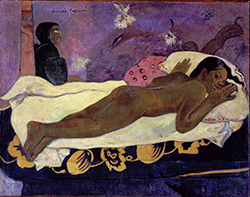 Painting by Paul Gauguin: Spirit of the Dead Watching (Manao tupapau) is an oil on burlap canvas depicting a naked Tahitian girl lying on her stomach. An old woman is seated behind her. Gauguin said the title may refer to either the girl imagining the ghost, or the ghost imagining her. The subject of the painting is Gauguin's young native wife Teha'amana (called Tehura in his letters), who one night, according to Gauguin, was lying in fear when he arrived home late: " ... motionless, naked, belly down on the bed: she stared up at me, her eyes wide with fear, '... Perhaps she took me, with my anguished face, for one of those legendary demons or specters, the Tupapaus that filled the sleepless nights of her people."
Painting by Paul Gauguin: Spirit of the Dead Watching (Manao tupapau) is an oil on burlap canvas depicting a naked Tahitian girl lying on her stomach. An old woman is seated behind her. Gauguin said the title may refer to either the girl imagining the ghost, or the ghost imagining her. The subject of the painting is Gauguin's young native wife Teha'amana (called Tehura in his letters), who one night, according to Gauguin, was lying in fear when he arrived home late: " ... motionless, naked, belly down on the bed: she stared up at me, her eyes wide with fear, '... Perhaps she took me, with my anguished face, for one of those legendary demons or specters, the Tupapaus that filled the sleepless nights of her people."
(no entry for this year)
1893
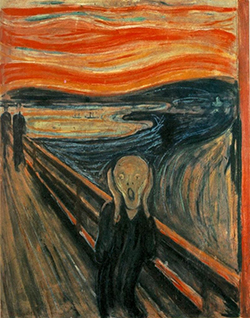 Painting by Edvard Munch: The Scream (Norwegian: Skrik). The same title — The Scream — is the popular name given to each of four versions of a composition, created as both paintings and pastels, by Norwegian Expressionist artist between 1893 and 1910. The German title Munch gave these works is Der Schrei der Natur (The Scream of Nature). The works show a figure with an agonized expression against a landscape with a tumultuous orange sky. Arthur Lubow has described The Scream as "an icon of modern art, a Mona Lisa for our time." Edvard Munch created the four versions in various media. The National Gallery in Oslo, Norway, holds one of two painted versions (1893, shown here). The Munch Museum holds the other painted version and a pastel version from 1893. The fourth version (pastel, 1895) was sold for $119,922,600 at Sotheby's Impressionist and Modern Art auction on 2 May 2012 to financier Leon Black, the fourth highest nominal price paid for a painting at auction. The painting was on display in the Museum of Modern Art in New York from October 2012 to April 2013.
Painting by Edvard Munch: The Scream (Norwegian: Skrik). The same title — The Scream — is the popular name given to each of four versions of a composition, created as both paintings and pastels, by Norwegian Expressionist artist between 1893 and 1910. The German title Munch gave these works is Der Schrei der Natur (The Scream of Nature). The works show a figure with an agonized expression against a landscape with a tumultuous orange sky. Arthur Lubow has described The Scream as "an icon of modern art, a Mona Lisa for our time." Edvard Munch created the four versions in various media. The National Gallery in Oslo, Norway, holds one of two painted versions (1893, shown here). The Munch Museum holds the other painted version and a pastel version from 1893. The fourth version (pastel, 1895) was sold for $119,922,600 at Sotheby's Impressionist and Modern Art auction on 2 May 2012 to financier Leon Black, the fourth highest nominal price paid for a painting at auction. The painting was on display in the Museum of Modern Art in New York from October 2012 to April 2013.
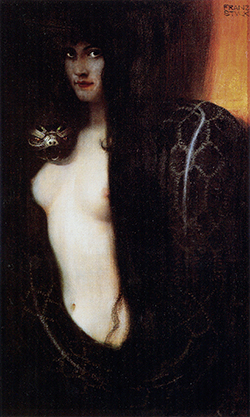 Painting by Franz Stuck: The Sin (German: Die Sünde) depicts the nude Eve with a big serpent wrapped around her body. In the upper right corner is a bright field, while the rest of the surroundings are dark. The motif was conceived as a development of Stuck's 1889 painting Sensuality (Die Sinnlichkeit). The Sin was first exhibited in 1893, at the inaugural exhibition of the Munich Secession, where it caused a sensation. It was bought by the Neue Pinakothek in Munich and became a critical and commercial breakthrough for Stuck. It has since become an emblematic painting for the symbolist movement. Stuck made twelve known versions of the painting. Some of these can be viewed at the Neue Pinakothek in Munich, the National Gallery in Berlin, the Galleria di arte Moderna in Palermo, the Frye Art Museum in Seattle, and at the Villa Stuck in Munich, where it is enshrined in the artist's Künstleraltar.
Painting by Franz Stuck: The Sin (German: Die Sünde) depicts the nude Eve with a big serpent wrapped around her body. In the upper right corner is a bright field, while the rest of the surroundings are dark. The motif was conceived as a development of Stuck's 1889 painting Sensuality (Die Sinnlichkeit). The Sin was first exhibited in 1893, at the inaugural exhibition of the Munich Secession, where it caused a sensation. It was bought by the Neue Pinakothek in Munich and became a critical and commercial breakthrough for Stuck. It has since become an emblematic painting for the symbolist movement. Stuck made twelve known versions of the painting. Some of these can be viewed at the Neue Pinakothek in Munich, the National Gallery in Berlin, the Galleria di arte Moderna in Palermo, the Frye Art Museum in Seattle, and at the Villa Stuck in Munich, where it is enshrined in the artist's Künstleraltar.
(no entry for this year)
1894
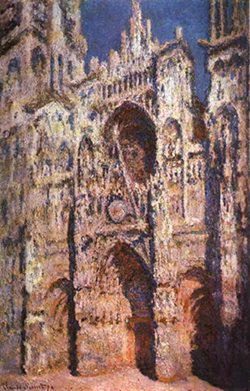 Painting by Claude Monet: The Rouen Cathedral, Full Sunlight was one of a series, with each painting in the series intended to capture the facade of the Rouen Cathedral at different times of the day and year, reflecting changes in its appearance under different lighting conditions. The Rouen Cathedral paintings, more than thirty in all, were made in 1892 and 1893, then reworked in Monet's studio in 1894. Monet rented spaces across the street from the cathedral, where he set up temporary studios for the purpose. In 1895, he selected what he considered to be the twenty best paintings from the series for display at his Paris dealer's gallery, and of these he sold eight before the exhibition was over. Pissarro and Cézanne visited the exhibition and praised the series highly. When Monet painted the Rouen Cathedral series, he had long since been impressed with the way light imparts to a subject a distinctly different character at different times of the day and the year, and as atmospheric conditions change. For Monet, the effects of light on a subject became as important as the subject itself.
Painting by Claude Monet: The Rouen Cathedral, Full Sunlight was one of a series, with each painting in the series intended to capture the facade of the Rouen Cathedral at different times of the day and year, reflecting changes in its appearance under different lighting conditions. The Rouen Cathedral paintings, more than thirty in all, were made in 1892 and 1893, then reworked in Monet's studio in 1894. Monet rented spaces across the street from the cathedral, where he set up temporary studios for the purpose. In 1895, he selected what he considered to be the twenty best paintings from the series for display at his Paris dealer's gallery, and of these he sold eight before the exhibition was over. Pissarro and Cézanne visited the exhibition and praised the series highly. When Monet painted the Rouen Cathedral series, he had long since been impressed with the way light imparts to a subject a distinctly different character at different times of the day and the year, and as atmospheric conditions change. For Monet, the effects of light on a subject became as important as the subject itself.
(no entry for this year)
1895
(no entry for this year)
(no entry for this year)
1896
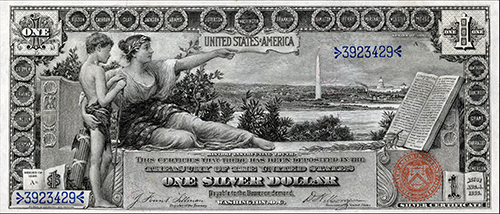 Currency as Art: United States, Educational Series, One Dollar Bill. "Educational Series" is the informal name used by numismatists to refer to a series of United States silver certificates produced by the U.S. Treasury in 1896. The One Dollar bill shows a personification of History instructing a youth, pointing to a panoramic view of the Potomac River and Washington, D.C. The Washington Monument and the Capitol are visible in the background. The United States Constitution is displayed to the right. Circling the motif are the last names of famous Americans.
Currency as Art: United States, Educational Series, One Dollar Bill. "Educational Series" is the informal name used by numismatists to refer to a series of United States silver certificates produced by the U.S. Treasury in 1896. The One Dollar bill shows a personification of History instructing a youth, pointing to a panoramic view of the Potomac River and Washington, D.C. The Washington Monument and the Capitol are visible in the background. The United States Constitution is displayed to the right. Circling the motif are the last names of famous Americans.
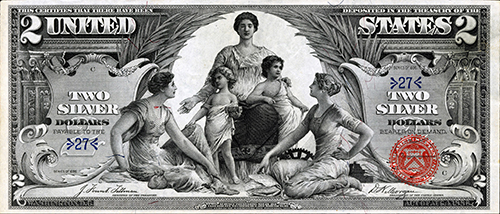 Currency as Art: United States, Educational Series, Two Dollar Bill. "Educational Series" is the informal name used by numismatists to refer to a series of United States silver certificates produced by the U.S. Treasury in 1896. The Two Dollar bill shows Science (center) presenting the two children, Steam and Electricity, to the more mature figures of Commerce (left) and Manufacture (right).
Currency as Art: United States, Educational Series, Two Dollar Bill. "Educational Series" is the informal name used by numismatists to refer to a series of United States silver certificates produced by the U.S. Treasury in 1896. The Two Dollar bill shows Science (center) presenting the two children, Steam and Electricity, to the more mature figures of Commerce (left) and Manufacture (right).
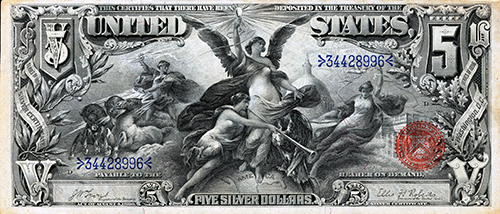 Currency as Art: United States, Educational Series, Five Dollar Bill. "Educational Series" is the informal name used by numismatists to refer to a series of United States silver certificates produced by the U.S. Treasury in 1896. The Five Dollar bill shows Electricity surrounded by other allegorical figures, representing the dominant force in the world. The United States Capitol building can be seen behind the female figures. The naked breasts of the female figures on the $5 silver certificate reportedly caused some minor controversy when several Boston society ladies took offense to the design. Some bankers reportedly refused to accept the notes in transactions, and the term "banned in Boston" allegedly originates from the $5 silver certificate.
Currency as Art: United States, Educational Series, Five Dollar Bill. "Educational Series" is the informal name used by numismatists to refer to a series of United States silver certificates produced by the U.S. Treasury in 1896. The Five Dollar bill shows Electricity surrounded by other allegorical figures, representing the dominant force in the world. The United States Capitol building can be seen behind the female figures. The naked breasts of the female figures on the $5 silver certificate reportedly caused some minor controversy when several Boston society ladies took offense to the design. Some bankers reportedly refused to accept the notes in transactions, and the term "banned in Boston" allegedly originates from the $5 silver certificate.
(no entry for this year)
1897
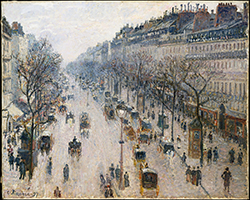 Painting by : The Boulevard Montmartre on a Winter Morning. In the late 1890s, Pissarro painted a series of works depicting the boulevards, as seen from his windows, at various times of year.
Painting by : The Boulevard Montmartre on a Winter Morning. In the late 1890s, Pissarro painted a series of works depicting the boulevards, as seen from his windows, at various times of year.
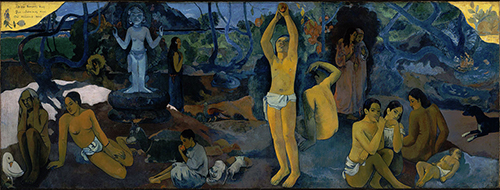 Painting by Paul Gauguin: Where Do We Come From? What Are We? Where Are We Going?. Gauguin inscribed the original French title in the upper left corner: D'où Venons Nous / Que Sommes Nous / Où Allons Nous. The inscription the artist wrote on his canvas has no question mark, no dash, and all words are capitalized. In the upper right corner he signed and dated the painting: P. Gauguin / 1897. The painting was created in Tahiti, and is in the Museum of Fine Arts in Boston, Massachusetts, USA. Gauguin had been a student at the Petit Séminaire de La Chapelle-Saint-Mesmin, just outside Orléans, from the age of eleven to the age of sixteen. His subjects there included a class in Catholic liturgy; the teacher for this class was the Bishop of Orléans, Félix-Antoine-Philibert Dupanloup. Dupanloup had devised his own catechism to be lodged in the minds of the young schoolboys, and to lead them towards proper spiritual reflections on the nature of life. The three fundamental questions in this catechism were: "Where does humanity come from?" "Where is it going to?", "How does humanity proceed?". Although in later life Gauguin was vociferously anticlerical, these questions from Dupanloup's catechism obviously had lodged in his mind, and "where?" became the key question that Gauguin asked in his art.
Painting by Paul Gauguin: Where Do We Come From? What Are We? Where Are We Going?. Gauguin inscribed the original French title in the upper left corner: D'où Venons Nous / Que Sommes Nous / Où Allons Nous. The inscription the artist wrote on his canvas has no question mark, no dash, and all words are capitalized. In the upper right corner he signed and dated the painting: P. Gauguin / 1897. The painting was created in Tahiti, and is in the Museum of Fine Arts in Boston, Massachusetts, USA. Gauguin had been a student at the Petit Séminaire de La Chapelle-Saint-Mesmin, just outside Orléans, from the age of eleven to the age of sixteen. His subjects there included a class in Catholic liturgy; the teacher for this class was the Bishop of Orléans, Félix-Antoine-Philibert Dupanloup. Dupanloup had devised his own catechism to be lodged in the minds of the young schoolboys, and to lead them towards proper spiritual reflections on the nature of life. The three fundamental questions in this catechism were: "Where does humanity come from?" "Where is it going to?", "How does humanity proceed?". Although in later life Gauguin was vociferously anticlerical, these questions from Dupanloup's catechism obviously had lodged in his mind, and "where?" became the key question that Gauguin asked in his art.
(no entry for this year)
1898
(no entry for this year)
(no entry for this year)
1899
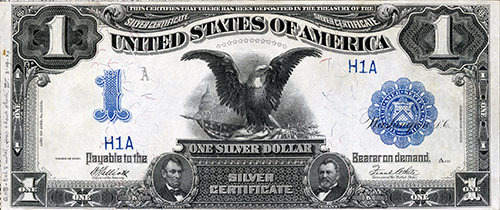 Currency as Art: The Black Eagle one-dollar silver certificate produced in 1899 in the United States. The note measured 7.38 × 3.18 in and featured a bald eagle with its wings spread. The note was also referred to as "Eagle of the Capitol", because the United States Capitol is visible behind the eagle. The note was issued from 1899 to 1923 and the Bureau of Engraving and Printing (BEP) printed 3,604,239,600 Black Eagles. The 1899 series replaced the 1896 Educational Series notes. One reason for the redesign was to make counterfeiting more difficult.
Currency as Art: The Black Eagle one-dollar silver certificate produced in 1899 in the United States. The note measured 7.38 × 3.18 in and featured a bald eagle with its wings spread. The note was also referred to as "Eagle of the Capitol", because the United States Capitol is visible behind the eagle. The note was issued from 1899 to 1923 and the Bureau of Engraving and Printing (BEP) printed 3,604,239,600 Black Eagles. The 1899 series replaced the 1896 Educational Series notes. One reason for the redesign was to make counterfeiting more difficult.
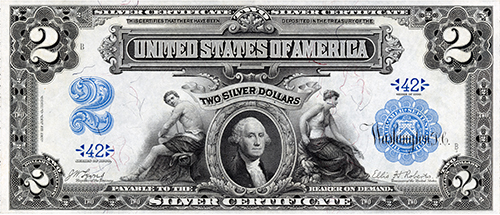 Currency as Art: In 1899, the US two-dollar Silver Certificate was redesigned with a small portrait of George Washington surrounded by allegorical figures representing agriculture and mechanics.
Currency as Art: In 1899, the US two-dollar Silver Certificate was redesigned with a small portrait of George Washington surrounded by allegorical figures representing agriculture and mechanics.
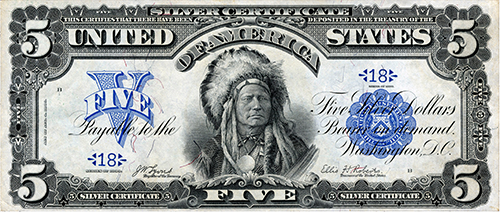 Currency as Art: The 1899 United States five-dollar Silver Certificate is known as the Indian Chief Note note. The note features Sioux chief Running Antelope. It is the only US federal paper currency featuring a named Native American. G.F.C. Smillie of the U.S. Bureau of Engraving and Printing (BEP) engraved the portrait of Running Antelope of the Hunkpapa Sioux which is found on this five-dollar Silver Certificate. During the photoshoot Running Antelope wore his three-feathered headdress but when engraving for the note, his headdress did not fit in the space of the 1899 five-dollar Silver Certificate. Smillie found an image of a feathered-War bonnet that was likely Pawnee and he used it in the engraving. Because of the incorrect headdress, the engraved portrait was controversial. The Sioux were enemies of the Pawnee so the depiction of a Sioux chief with his enemies war bonnet became a controversy.
Currency as Art: The 1899 United States five-dollar Silver Certificate is known as the Indian Chief Note note. The note features Sioux chief Running Antelope. It is the only US federal paper currency featuring a named Native American. G.F.C. Smillie of the U.S. Bureau of Engraving and Printing (BEP) engraved the portrait of Running Antelope of the Hunkpapa Sioux which is found on this five-dollar Silver Certificate. During the photoshoot Running Antelope wore his three-feathered headdress but when engraving for the note, his headdress did not fit in the space of the 1899 five-dollar Silver Certificate. Smillie found an image of a feathered-War bonnet that was likely Pawnee and he used it in the engraving. Because of the incorrect headdress, the engraved portrait was controversial. The Sioux were enemies of the Pawnee so the depiction of a Sioux chief with his enemies war bonnet became a controversy.
ESP Quick Facts
ESP Origins
In the early 1990's, Robert Robbins was a faculty member at Johns Hopkins, where he directed the informatics core of GDB — the human gene-mapping database of the international human genome project. To share papers with colleagues around the world, he set up a small paper-sharing section on his personal web page. This small project evolved into The Electronic Scholarly Publishing Project.
ESP Support
In 1995, Robbins became the VP/IT of the Fred Hutchinson Cancer Research Center in Seattle, WA. Soon after arriving in Seattle, Robbins secured funding, through the ELSI component of the US Human Genome Project, to create the original ESP.ORG web site, with the formal goal of providing free, world-wide access to the literature of classical genetics.
ESP Rationale
Although the methods of molecular biology can seem almost magical to the uninitiated, the original techniques of classical genetics are readily appreciated by one and all: cross individuals that differ in some inherited trait, collect all of the progeny, score their attributes, and propose mechanisms to explain the patterns of inheritance observed.
ESP Goal
In reading the early works of classical genetics, one is drawn, almost inexorably, into ever more complex models, until molecular explanations begin to seem both necessary and natural. At that point, the tools for understanding genome research are at hand. Assisting readers reach this point was the original goal of The Electronic Scholarly Publishing Project.
ESP Usage
Usage of the site grew rapidly and has remained high. Faculty began to use the site for their assigned readings. Other on-line publishers, ranging from The New York Times to Nature referenced ESP materials in their own publications. Nobel laureates (e.g., Joshua Lederberg) regularly used the site and even wrote to suggest changes and improvements.
ESP Content
When the site began, no journals were making their early content available in digital format. As a result, ESP was obliged to digitize classic literature before it could be made available. For many important papers — such as Mendel's original paper or the first genetic map — ESP had to produce entirely new typeset versions of the works, if they were to be available in a high-quality format.
ESP Help
Early support from the DOE component of the Human Genome Project was critically important for getting the ESP project on a firm foundation. Since that funding ended (nearly 20 years ago), the project has been operated as a purely volunteer effort. Anyone wishing to assist in these efforts should send an email to Robbins.
ESP Plans
With the development of methods for adding typeset side notes to PDF files, the ESP project now plans to add annotated versions of some classical papers to its holdings. We also plan to add new reference and pedagogical material. We have already started providing regularly updated, comprehensive bibliographies to the ESP.ORG site.
ESP Picks from Around the Web (updated 06 MAR 2017 )
Old Science

Weird Science

Treating Disease with Fecal Transplantation
Fossils of miniature humans (hobbits) discovered in Indonesia

Dinosaur tail, complete with feathers, found preserved in amber.
Astronomy

Mysterious fast radio burst (FRB) detected in the distant universe.